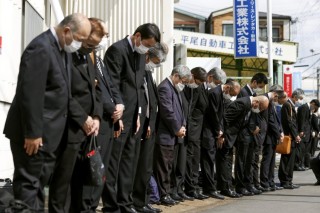Loading
Search
▼ 107 Victims Of 2005 Fatal Train Derailment In Hyogo Remembered
- Category:Event
West Japan Railway Co (JR West) officials, survivors and relatives of victims of a train derailment in 2005 in Amagasaki, Hyogo Prefecture, on Monday placed flowers at a memorial site.
Since the accident, a memorial service has been held each year, attended by relatives of victims and JR West officials. But due to the coronavirus, no service was held in 2020 and last year.
On April 25, 2005, a speeding train on the JR Fukuchiyama Line jumped the tracks on a tight bend during the morning rush hour and plowed into a residential tower. The driver and 106 passengers died in the accident, which also left 562 people injured in Japan's worst rail disaster for four decades.
It was determined later that the 23-year-old driver had been going over the speed limit on a curve because he was running late. The driver had been disciplined twice before the accident for running behind schedule.
JR West President Kazuaki Hasegawa placed flowers at the site and observed a minute of silence at 9:18 a.m., the exact moment the derailment occurred on a section of the JR Fukuchiyama Line between Tsukaguchi and Amagasaki stations.
JR West has turned the accident site into a place of remembrance where visitors can pray for the dead. It has preserved part of the now-vacant condominium building and covered the location with a roof in 2018. A monument bears the names of the victims.
In the aftermath of the crash, four JR West executives were charged with professional negligence -- Shojiro Nanya, 72, Masao Yamazaki, 68, Masataka Ide, 78, and Takeshi Kakiuchi, 69. All four were found not guilty by the Kobe District Court.
Family members of the crash victims said JR West should have been held accountable for failing to take proper safety precautions such as installing an Automatic Train Stop (ATS) device that can stop a train from traveling too fast. The company's corporate culture of punishing employees for their mistakes was also harshly criticized.
But the court ruled that the four executives did not have proper opportunities to recognize the danger and that they were also not legally obliged to install such a device when the accident occurred.
In June 2017, an appeal filed by lawyers who served as prosecutors in the case was rejected by the Supreme Court.
© Japan Today
Since the accident, a memorial service has been held each year, attended by relatives of victims and JR West officials. But due to the coronavirus, no service was held in 2020 and last year.
On April 25, 2005, a speeding train on the JR Fukuchiyama Line jumped the tracks on a tight bend during the morning rush hour and plowed into a residential tower. The driver and 106 passengers died in the accident, which also left 562 people injured in Japan's worst rail disaster for four decades.
It was determined later that the 23-year-old driver had been going over the speed limit on a curve because he was running late. The driver had been disciplined twice before the accident for running behind schedule.
JR West President Kazuaki Hasegawa placed flowers at the site and observed a minute of silence at 9:18 a.m., the exact moment the derailment occurred on a section of the JR Fukuchiyama Line between Tsukaguchi and Amagasaki stations.
JR West has turned the accident site into a place of remembrance where visitors can pray for the dead. It has preserved part of the now-vacant condominium building and covered the location with a roof in 2018. A monument bears the names of the victims.
In the aftermath of the crash, four JR West executives were charged with professional negligence -- Shojiro Nanya, 72, Masao Yamazaki, 68, Masataka Ide, 78, and Takeshi Kakiuchi, 69. All four were found not guilty by the Kobe District Court.
Family members of the crash victims said JR West should have been held accountable for failing to take proper safety precautions such as installing an Automatic Train Stop (ATS) device that can stop a train from traveling too fast. The company's corporate culture of punishing employees for their mistakes was also harshly criticized.
But the court ruled that the four executives did not have proper opportunities to recognize the danger and that they were also not legally obliged to install such a device when the accident occurred.
In June 2017, an appeal filed by lawyers who served as prosecutors in the case was rejected by the Supreme Court.
© Japan Today
- April 25, 2022
- Comment (0)
- Trackback(0)


